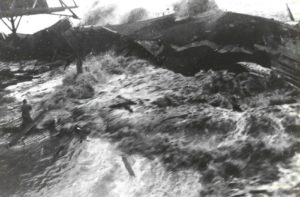FEMA Encourages Tsunami Awareness for Coastal Communities

Tsunami inundating Hilo, Hawaii. Note man on pier. This disaster provided impetus for C&GS to establish tsunami warning system
Image ID: theb2705, NOAA’s Historic Coast & Geodetic Survey (C&GS) Collection
Location: Hilo, Hawaii
Photo Date: April 1946
Credit: NOAA
After a 7.9 magnitude quake in the Gulf of Alaska prompted tsunami watches, advisories and warnings across many state coastlines, FEMA continues to highlight safety tips for those who live in or visit coastal communities.
At 11:32 p.m. HST on Monday, Jan. 22, a 7.9 magnitude quake was reported off the Gulf of Alaska. The Pacific Tsunami Warning Center initially issued a tsunami watch for Hawaiʻi, but cancelled it about an hour later at 1:10 a.m. following an assessment showing no tsunami threat to the state.
FEMA says that while the immediate threat has passed, the situation serves as a reminder to all that there are steps that can be taken now, to prepare for future events.
According to the National Oceanic and Atmospheric Administration, tsunamis are one of the most powerful and destructive natural forces, delivering a series of extremely long waves which can cause dangerous coastal flooding and powerful currents that can last for several hours or days. Caused by an underwater disturbance such as an earthquake, landslide, volcanic eruption, or meteorite, tsunamis radiate outward in all directions from the point of origin and can move across entire ocean basins.
If a major earthquake or landslide occurs close to shore, areas are at greater risk if they are less than 25 feet above sea level and within a mile of the shoreline. The first wave in a series could reach the beach in a few minutes, even before a warning is issued.
FEMA encourages citizens to protect themselves and their families by taking the following steps to ensure they are ready in the event of a tsunami:
- Create and practice an evacuation plan with your family. If you live in a tsunami evacuation zone you will find signs in your community. Familiarity may save your life. Be able to follow your escape route at night and during inclement weather.
- Create a family communications plan to know how you’ll contact each other and reconnect if separated. Establish a family meeting place that’s familiar and easy to find.
- Build an emergency kit to ensure you and your family are prepared to be on your own for at least 72 hours.
- If you are a tourist, familiarize yourself with local tsunami evacuation protocols.
Familiarize yourself with tsunami notification information:
Tsunami Watch
-
-
- A tsunami watch is issued to alert emergency management officials and the public of an event which may later impact the watch area.
- Prepare to take action and stay alert for further information.
-
Tsunami Advisory
A tsunami advisory is issued when a tsunami with the potential to generate strong currents or waves dangerous to those in or very near the water is imminent or expected. The threat may continue for several hours after initial arrival, but significant inundation is not expected for areas under an advisory.
Tsunami Warning
-
-
- A tsunami warning is issued when a tsunami with the potential to generate widespread inundation is imminent or expected.
-
-
-
- Warnings alert the public that dangerous coastal flooding accompanied by powerful currents is possible and may continue for several hours after initial arrival.
- Move inland, out of the water, off the beach, and away from harbors, marinas, breakwaters, bays and inlets.
- Be alert to and follow instructions from your local emergency officials because they may have more detailed or specific information for your location.
- If you feel a strong earthquake or extended ground rolling take immediate protective actions such as moving inland and/or uphill preferably by foot.
- If told to evacuate, evacuate immediately, taking your animals with you.
- If you are in a high-rise building and instructed to shelter in place, stay on floors just above flood water. Stay in hallways or interior rooms.
- Do not return to the coast until local emergency officials indicate it is safe to do so.
-
The FEMA App provides National Weather Service alerts, safety tips for what to do before/during/after more than 25 natural & man-made emergencies, emergency kit and family communication plan checklists, and more.
For more information about tsunamis and how to prepare click here.















